Getting Back to Basics: Understanding Breast Health, Awareness, and Mammograms

That little pink ribbon. We’ve all seen it every October — on shirts, football fields, storefronts, and social media — as a symbol of unity and awareness for those affected by breast cancer. But beyond the color and campaigns lies a powerful message: early detection saves lives, and prioritizing breast health shouldn’t be limited to one month a year.
A Brief History of Breast Cancer Awareness Month
Breast Cancer Awareness Month (BCAM) began in 1985 as a partnership between the American Cancer Society and the pharmaceutical division of Imperial Chemical Industries. The campaign was first championed by Betty Ford, a breast cancer survivor and former First Lady, who used her platform to shine a national spotlight on the importance of early detection and open conversations about breast health.
From these early efforts, BCAM grew into a global movement. In 1992, Estée Lauder Companies helped launch the iconic pink ribbon, distributing more than 1.5 million ribbons and cementing it as the universal symbol of breast cancer awareness. Today, this symbol continues to remind us of the importance of research, support, and screening — not just in October, but all year long.
What Is a Mammogram? (Back to the Basics)
A mammogram is a specialized X-ray of the breast designed to detect signs of breast cancer early — often before any lump can be felt. It’s one of the most effective tools available for early detection, allowing for a wider range of treatment options and the best possible outcomes.
There are two main types of mammograms:
- Screening Mammogram – A routine exam for women who have no signs or symptoms of breast disease.
- Diagnostic Mammogram – A more detailed exam used to investigate specific concerns, such as a lump, nipple discharge, or abnormal screening result.
How a Mammogram Is Done
During your exam, you’ll stand in front of a specialized X-ray machine. A technologist will gently place one breast at a time between two plates. These plates briefly compress the breast — this compression is key to obtaining clear, accurate images. Each compression lasts just a few seconds, and while it may be uncomfortable, it’s quick and essential for detecting even the smallest changes in breast tissue.
At Diagnostic Imaging Northwest, we offer 3D mammography (digital breast tomosynthesis) — an advanced technology that takes multiple images of the breast in thin layers, allowing our radiologists to examine breast tissue in greater detail and detect abnormalities that might otherwise be hidden.
Tips for Your Mammogram Appointment
- Try not to schedule your mammogram the week before or during your period, as breasts may be more tender.
- Avoid wearing deodorant, perfume, or powder under your arms or on your breasts — these can appear as white spots on your X-ray.
- If you have previous mammogram images from another facility, please let our team know so we can compare your results for accuracy.
- Always inform your technologist if you are pregnant, nursing, or have breast implants.
What to Expect at Diagnostic Imaging Northwest
When you come in for your mammogram, you can expect skilled, compassionate care every step of the way. Our all-female technologist team will review your history, answer your questions, and ensure your comfort throughout the process.
- Screening Mammograms typically take about 30 minutes.
- Diagnostic Mammograms take about an hour and include immediate review by a radiologist.
- Results are sent to your healthcare provider within 24–48 hours, and if further imaging is needed, we’ll guide you through the next steps promptly and supportively.
Why Annual Screenings Matter
The physicians at Diagnostic Imaging Northwest strongly believe that routine screening mammography and early detection save lives. We follow the American College of Radiology’s recommendation to begin annual screening at age 40.
We also encourage:
- Regular clinical breast exams by your healthcare provider starting at age 20
- Monthly self-exams to understand what’s normal for your breasts and report any changes
A Reminder for Every Month
October’s pink ribbons remind us to honor those affected by breast cancer — survivors, fighters, and loved ones alike. But your breast health deserves attention every month of the year.
Take a moment today to schedule your mammogram, encourage a friend to do the same, and keep the conversation about breast health going — because early detection can make all the difference.
Schedule your mammogram today:
253-841-4353
Screening mammograms do not require a referral.
Additional Resources:
- https://www.cdc.gov/breast-cancer/about/mammograms.html
- https://www.brevardhealth.org/blog/a-brief-history-of-breast-cancer-awareness-month/
- https://www.dinw.com/services/mammography/
